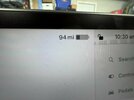AlanSubie4Life
Efficiency Obsessed Member
As mentioned above, @outdoors has shared that his 2017 Model 3 LR RWD with 150k miles has 296 miles of rated range at 100%, which means it has a BMS-estimated capacity of 69.3kWh, using the very well-known 234Wh/rmi constant for that vehicle, which precisely matches the 239Wh/mi position of the rated line in the vehicle (always higher by 5Wh/mi). (When new, this vehicle type had around 78kWh of capacity, and displayed either 310 rated miles or 325 rated miles (depending on the software version), when the vehicle capacity exceeded 76kWh; 76kWh is the degradation threshold for that vehicle; FPWN from SMT readback of pack is 77.8kWh.)Until you are willing to share your BMS data and/or Teslafi data I am not willing to take your word on any numbers.
That is mostly sufficient information for the discussion at hand; ~11% loss. (A few more pieces of info would be required to fit that vehicle to @AAKEE's formula, but I doubt there is any interest in doing so.
Last edited:




